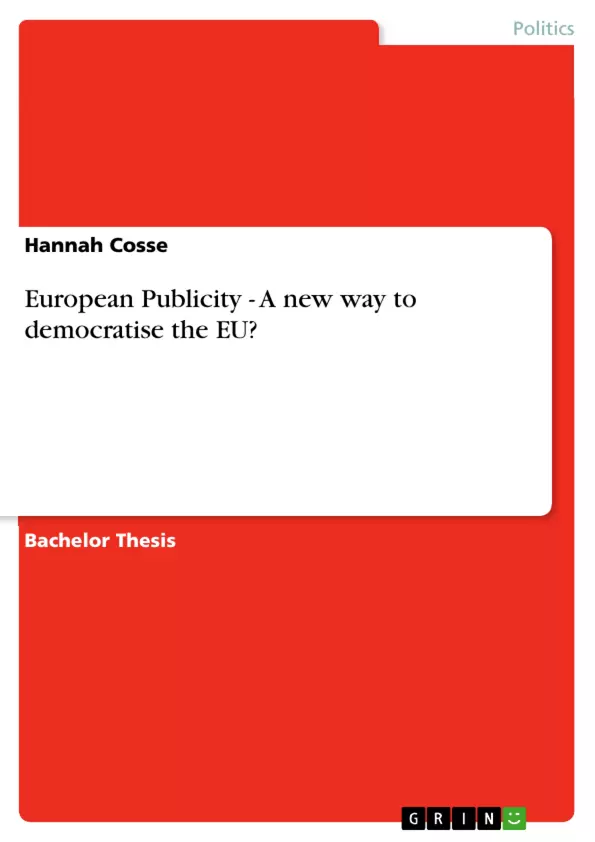I.1. Introduction and Problem Definition
On its way from an economical partnership to a political union the EU has faced a long-time debate about its democratic deficits. Discussions and proposed remedies focused mainly on the institutional side of the problem and the ques-tion of how the institutions can be democratised. Since the 1990s the debate about European identity and citizenship attracted the limelight of the political debate within the European Union. However, this paper will neither focus on the institutional nor on the identity part of the debate about the democratic deficits of the EU, but will focus on a dimension in between.
Direct democracy, as in the Greek city states, is, because of the size of modern democracies, not feasible anymore. The media is needed to communicate deci-sions (top-down) as well as the will of the people (bottom-up). (Mass-) media creates publicity. On a national level there is a network of print, TV and online media, which creates a tight arrangement of top-down and bottom-up communi-cation: national publicity. The European Union, with its multi-level-governance structures and the heterogeneous identities, is more complex than a nation state.
European Publicity can be seen from two angles: In the first place European Publicity as “EU wide publicity” – which means Europe wide media and also a common communication-place for European topics from a huge variety of par-ticipants. From this angle the lack of “a common European Media” – although attempts like “Euronews” are a first step - could be analysed. Furthermore there is a language problem with regard to “EU wide publicity”. Within the EU there is no common language; therefore there cannot be (at the moment) media which is comprehensible for everyone. To summarize this part of European publicity: If no one listens there cannot be publicity. But this view is of no relevance for this paper. [...]
Inhaltsverzeichnis (Table of Contents)
- I. Introduction and Methodology
- I.1. Introduction and Problem Definition
- I.2. Methodology and Research Design
- II. The Model
- II.1. Publicity as interaction between EU-MLG and Europeans
- II.1.a. The Basics
- II.1.a.1. What is meant by EU-MLG?
- II.1.a.2. Who are Europeans?
- II.1.a.3. What is meant by Publicity?
- II.1.b. The influence of Media
- II.1.b.1. Media and EU-MLG
- II.1.b.2. Media and Europeans
- II.1.b.3. Media and Publicity
- II.2. Publicity as a Requirement for Democracy
- II.2.a. An ideal Democracy
- II.2.b. The Role of Publicity in a Democracy
- II.3. The Model in a Nutshell
- III. The Reality
- III.1. Preliminary Remarks
- III.2. Newspaper Analysis
- III.2.a. Inter-Event-Comparison
- III.2.b. Inter-Newspaper-Comparison
- III.3. Results of the Newspaper Analysis
- IV. Conclusion
Zielsetzung und Themenschwerpunkte (Objectives and Key Themes)
This paper explores the relationship between European publicity and the democratic deficit within the European Union. The research question focuses on the extent to which European publicity, as measured by media coverage, relates to the level of democracy in the EU. The paper argues that publicity is crucial for the interaction between the EU’s multi-level governance (EU-MLG) and European citizens, facilitating both top-down and bottom-up communication.
- The role of media in creating and shaping European publicity
- The impact of European publicity on democratic processes in the EU
- The importance of a functioning communication network between the EU-MLG, media, and European citizens
- The implications of insufficient European publicity for democracy within the EU
- The analysis of German newspapers to understand the level of European publicity and its influence on democratic representation
Zusammenfassung der Kapitel (Chapter Summaries)
The paper begins by introducing the concept of European publicity and its significance in a multi-level governance system like the EU. It then delves into the methodology and research design, explaining the rationale behind the choice of newspapers and the timeframe for the analysis. This includes an explanation of the selection criteria for the newspapers and the two specific time periods chosen for comparison. The second chapter introduces a model that highlights the interaction between the EU-MLG, European citizens, and European publicity. This model emphasizes the role of media in facilitating communication between these actors and its influence on democracy. The chapter also explores the theoretical basis for this model, drawing on concepts of ideal democracy and the role of publicity in a democratic system.
The third chapter shifts to the practical application of the model through a detailed analysis of the selected German newspapers. This includes an examination of the media coverage of European issues in relation to national issues, highlighting the differences in publicity between the two time periods. Finally, the paper offers a preliminary assessment of the data and findings, providing a brief overview of the relationship between media coverage and democratic representation within the EU. This analysis aims to establish a connection between the lack of sufficient European publicity and the perception of a democratic deficit.
Schlüsselwörter (Keywords)
The main keywords and focus topics of this paper include European publicity, democratic deficit, media coverage, multi-level governance, communication, EU-MLG, European citizens, democracy, newspaper analysis, and German media landscape.
- Quote paper
- Hannah Cosse (Author), 2005, European Publicity - A new way to democratise the EU?, Munich, GRIN Verlag, https://www.grin.com/document/65880



